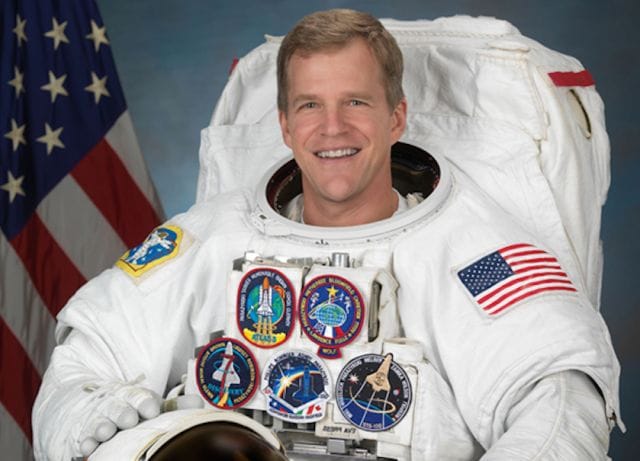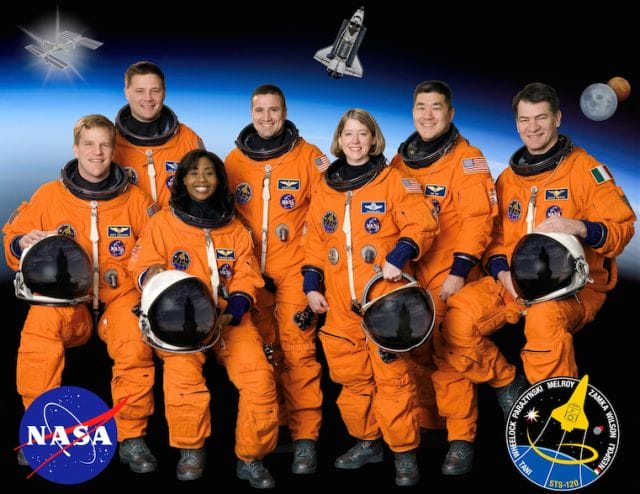On a sunny day in 1966, five-year-old Scott Parazynski posed for a photo. Clad in a fuzzy sweater, and clutching a red, white and blue toy rocket, he stood in the looming shadows of a massive NASA hangar, oblivious to the fact that he’d one day be launched to space on one of the organization’s shuttles.
In the fifty years since the photo was taken, Parazynski has lived what he modestly calls “a charmed life:” he graduated with honors from Stanford Medical School, competed in the Olympic Trials as a luger, traveled to space on five missions, summited Mount Everest, and now oversees medical operations for scientists stationed in Antarctica.
At Priceonomics, we’ve always been especially curious about what it takes — both mentally and physically — to be an astronaut, so we took some time to chat with one; this is his story.
A Promising Start
Born in Little Rock, Arkansas in 1961, Parazynski led an atypical childhood. His father, an Air Force rocket scientist who worked on the Apollo Saturn V rockets (the first to successfully land men on the moon), often exposed his son to influential people. “I’ll never forget the time he brought home a deputy of Wernher von Braun — the ‘Father of Rocket Science’ — for dinner,” Parazynski recalls. “I don’t remember much of what he said other than he had a really thick German accent, but they sat around talking about rockets, meteors, the moon. It was an experience that set my targets on space early on.”
Parazynski’s unique lifestyle came at the cost of constant mobility. He lived in New Orleans, Washington D.C., Dakar, Senegal, Lebanon, and Greece — all by the time he graduated high school. In 1979, he embarked to California to pursue a biology degree at Stanford University; he’d continue onto medical school there.
While pursuing his MD, Parazynski became involved with ice luging — a sport that requires a rider to careen down a course at 80 miles per hour at up to six G’s of force. Naturally athletic and a hard worker, he quickly became one of the top-ranked competitors in the nation, and went on to race with the USA Luge Team at the 1988 Olympic trials.
Upon completion of his program in 1989, he served his medical internship at Harvard, and subsequently enrolled in an emergency medicine residency program in Denver. Then, two years into his medical career, Parazynski responded to an ad placed by the NASA Astronaut Corps, and was called in for interviews.
Life as an Astronaut
The team of STS-120, Parazynski’s (far left) final flight in 2007
NASA is notoriously particular in its hiring process, and for good reason: an astronaut has to be both physically and mentally made of steel. Since selecting its first “Original Seven” astronauts in 1959 (all pilots by trade), NASA has conducted 20 rounds of astronaut hiring — about one every two to three years. Out of tens of thousands of candidates — from schoolteachers to biologists — only 330 have ever been accepted, making an astronaut one of the most competitive jobs to land in the world.
Parazynski was one of only 19 U.S. citizens chosen for the intensive Astronaut Candidate training program, a process that entailed a year of training and preparation. “It’s challenging to train for space because it’s just impossible to simulate exactly what it’s going to be like out there,” he recalls, “so NASA tries to mitigate the unknown through all these processes.” Astronauts go through high-G-force training using giant centrifuges, are placed in parabolic flight simulators, and must be familiarized with neutral buoyancy training, among other things. Similarly, all astronauts are required to log hours in high-performance jet aircraft (specifically, the U.S. Airforce’s T-38 Jet trainer).
The training period is also an opportunity for prospective astronauts to expand their knowledge in a variety of fields. Doctors, like Parazynski, are hired not just to be physicians, but generalists. “Much of that first year was spent learning about oceanography, meteorology, material science, combustion physics, astrophysics — all the various fields of science engineering that apply to the space program as a whole,” he says. “You’re always learning a new area of science, and it’s really a lot of fun.”
But even after completing all necessary training, a quick ascent to space isn’t guaranteed — one of Parazynski’s colleagues waited 17 years to achieve flight. Impressively (and luckily), Parazynski was enlisted as a mission specialist a mere year after his recruitment.His first mission placed him aboard the ATLAS-3, a shuttle that sought to “determine the Earth’s energy balance and atmospheric change over an 11-year solar cycle, particularly with respect to humanity’s impact on global-ozone distribution.” In his 11 day journey in space, Parazynski and the ATLAS crew circled Earth 175 times, travelling more than 4.5 million miles.
Parazynski repairing a damaged solar panel in the International Space Station
The following year, he was slated to accompany Russian cosmonauts in a long-duration stay at the Mir station, but, at 6’2”, was deemed “too tall” to safely fit in the Soyuz shuttle, and was withdrawn from the mission. He didn’t have to wait long to return to space though: in 1997, he boarded the Atlantis, docked at Mir, and partook in the first shuttle-based joint American-Russian spacewalk in history. With renowned Russian astronaut Vladimir Titov, Parazynski embarked on a five-hour spacewalk — a moment he describes as “a career highlight.” He was also tasked with repairing a damaged hull in the station — something that might be accomplished in a few hours on Earth. But in space, even simple tasks require a tremendous amount of resourcefulness — or, in the words of Parazynski, “It’s not like you can just go to Home Depot and get what you need.”
Aboard Discovery in 1998, Parazynski spent nine days testing systems that would eventually be flown to the Hubble telescope, and served as the flight engineer and navigator. But he served an even more important role as 77-year-old Senator John Glenn’s personal in-flight physician. “Man, that was very stressful,” he recalls. “If anything happened to him, I might as well not come home.”
Parazynski on a spacewalk in 2007
But Parazynski returned, and would fly two more missions — 2001’s Endeavour (a joint flight with Canadian Chris Hadfield, who’d later sing this awesome David Bowie cover in space), and 2007’s Discovery (which delivered elements to the Internationals Space Station which made future expansion more readily achievable).
Over five space flights spanning thirteen years, Parazynski logged nearly 1,019 hours — or 8 weeks — in space, and traveled over 17 million miles. From out in space, Earth was just a tiny, glowing orb, and it put the planet’s fragility into perspective. “It’s impossible for an astronaut to go into space and not come back, to some degree, an environmentalist,” he told CNN in 2011. “You see how beautiful and unique the planet is, in the entirety of the universe.” And how does it feel to look up into the stars and know you were out there somewhere? He explains:
“It [takes] my breath away on some clear nights when I take the time to really look at the night’s sky. At dusk you can often see satellites zooming across the starfield overhead, still illuminated by the sun while it’s already dark at ground level. It’s hard to imagine having been outside in a spacesuit, traveling in formation outside of a satellite like the Russian Mir space station or the ISS, traveling that high, that fast…”
Parazynski returned from his last flight with a rekindled desire to achieve another life-long dream: summiting Mount Everest.
Such Great Heights
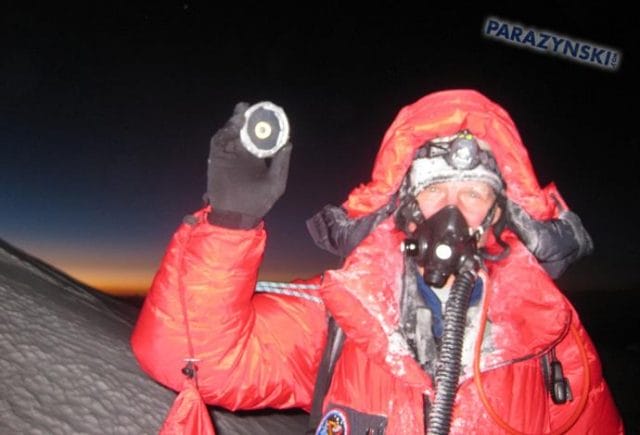
Parazynski holding an Apollo 11 lunar sample on the summit of Mount Everest; Source: Scott Parazynski
Mount Everest, at 29,029 feet, is the tallest peak in the world. Straddling the border of China and Nepal, the mountain attracts expert climbers from around the world. It is also one of the deadliest pursuits on Earth: lack of oxygen, extreme cold, exhaustion, and steep, technical pitches all pose major challenges for even the fittest mountaineers. Often, the last mile to the peak — known as the “Death Zone” — takes 12 hours to ascend, and requires up to two months of advance acclimatization in the Himalayas. But none of this concerned Scott Parazynski; after all, he’d been to space.
In 2008, at 46 years old, the astronaut took a leave from NASA and rallied to climb the mountain. Though he’d gone through years of intense training for space, Parazynski claims the preparation for Everest was much more grueling. Months of spin aerobics, stadium steps, and weightlifting built up his aerobic base; getting all of his gear in order was equally exhausting. “It’s like taking a spacesuit with you, in a few ways,” he says. “You’ve got the down suit, the pack, carabiners, crampons, ice axe — this endless list of considerations just to prepare you for this environment.” Then there was the mental challenge of leaving his wife and two children for two months.
Climbing Everest is also a considerable financial investment. The trek starts at around $35,000 — $10,000 for the appropriate permits alone, and thousands more to hire a team of Sherpas (porters, cooks, guides). Astronauts don’t make a ton of money (they start at around $64,000, and peak at $141,000 after years of work); as an unguided climber, Parazynski had to take out a $40,000 home loan to fund his journey.
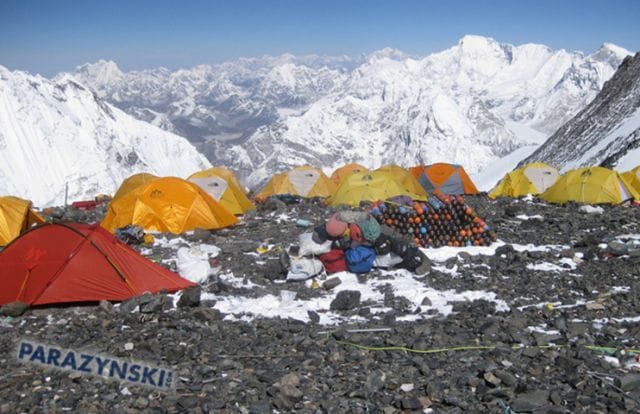
Source: Scott Parazynski
On the mountain, Parazynski was one of the fittest climbers on his team. He acclimatized well, and was at 24,500 feet — a mere 24 hours from the summit — when he had to make “the most difficult decision of [his] life.” On the morning of his 59th day, as he got ready to make a push for the top, he “hit a world of hurt:” a ruptured disc in his lower back derailed his ability to continue on, and he had to slowly, painfully descend.
Parazynski wasn’t used to failure, and knew he had to try again. But to do so, he’d have to take a leave without pay — something he couldn’t afford to do. He knew that if he were to fly another mission, it’d be “at least 5 to 10 more years,” so in 2009, he retired from the astronaut corps, and invested himself full-time in Everest training. A year later, Parazynski returned to Everest — this time, fully sponsored by SPOT (a GPS company), and The Discovery Channel as a team physician. On May 20, 2009, at 4:00 am, he successfully summited the mountain.
Many parallels can be drawn between space and Everest, says Parazynski, but Everest is on an entirely different level of rigor.
“Inside of a space suit, you feel comfortable — you’re not gasping for breath. When you’re up there, you’re just having the time of your life,” he says. “On the mountain, you’re cold, you feel the hypoxia and imminent threats around you. Your eyeballs could be fried from ultraviolet radiation, or you could encounter pulmonary edema, where your lungs essentially fill up with liquid. It’s very, very, indescribably intense. You have to give it everything you have got every step of the way.”
The Boy With the Rocket
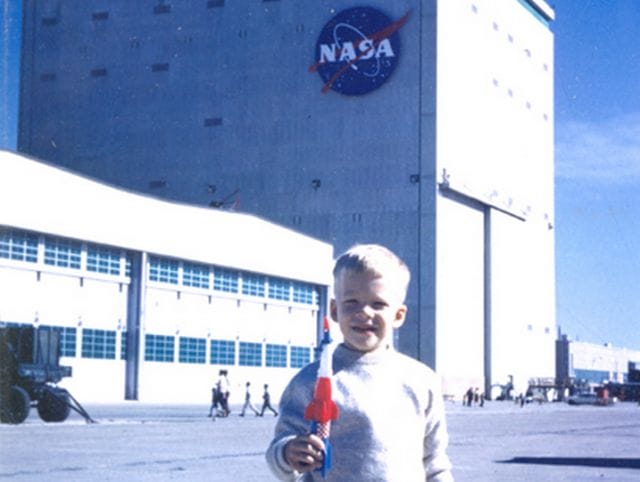
Photo: Scott Parazynski
Three years before departing to climb Everest, Parazynski had founded his own medical device company, aptly named Apogee Surgical Innovations, which “engaged in launching new innovative products for surgical and medical care.” Upon returning, he served as a board member on various medical and aircraft committees.
Today, Parazynski characteristically stays busy, with a hand in both space and medicine. As Chief Medical Officer and Director of the UTMB Health Center for Polar Operations, he oversees health care for National Science Foundation participants in Antarctica. As a public speaker, he travels the world giving talks on extreme environment exploration, risk management, and leadership — “both on and off the planet.” Until last year, he also served as chairman of the Challenger Center for Space Science Education — an organization focused on inspiring young people to pursue stem careers through hands-on simulated space missions.
A part-time spaceflight consultant for the commercial spaceflight sector, Parazynski also has high hopes for the future accessibility of space. “Companies like SpaceX, Virgin Galactic, and Blue Origin will be able to provide a small taste of what it’s like to be an astronaut someday,” he says. “It’s really the barnstorming era of spaceflight.” Though most commercial flights are somewhere in the perceived range of $200,000, prices are likely to drop to around $50,000 in the near future, for an experience that takes you “about 100 miles up into space.”
As a mountaineer, he’s now scaled all 59 of Colorado’s 14,000+ foot peaks, and has added South America’s Aconcagua (22,841 feet) and Alaska-range mountains to his list of accomplishments. His next big adventure? He plans to climb Kilimanjaro this winter with his wife, and share the mountains with his son, a high school senior.
Though Parazynski’s life has taken him to the extremes of the universe — space, Everest, Antarctica — he claims to have failed in his real dream, “to set the first boot prints on Mars.” But he has no regrets. “I’ve led a fortunate life,” he reflects, “and it’s a great time to be alive.”
This post was written by Zachary Crockett. Follow him on Twitter here, or Google Plus here.




